To do a common thing uncommonly well brings success. —Henry J. Heinz, Founder of the H.J. Heinz Company
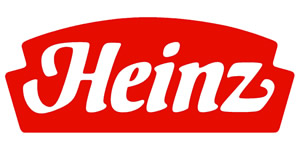
The word "success" is an understatement when describing Henry J. Heinz and his namesake company. From humble beginnings as a local horseradish producer in 1869, Henry Heinz combined an entrepreneurial spirit with innovative advertising to create the H.J. Heinz Company, a $10 billion Fortune 500 corporation today. With its global headquarters located at its origins of Pittsburgh's North Side, the Heinz Co. packages joy within every jar of pickles, every bottle of vinegar, and every bottle of ketchup that it sells each year.
Born on October 11, 1844, Henry John Heinz grew up in Sharpsburg, a borough of Pittsburgh, Pennsylvania. Here, at the age of eight, the young Heinz started selling extra vegetables grown in his family garden to neighbors. By the age of twelve, Heinz farmed three and a half acres of land, on which he specialized growing horseradish root. He started selling his homemade horseradish door-to-door to the residents of Sharpsburg. This early success in food processing would take a brief, but important, detour. At 21, Heinz bought a half interest in his father's brick business. Three years later, he partnered with L. C. Noble to manufacture and sell bricks—his first business venture outside the family. The following year, in 1869, Heinz and Noble abandoned bricks and returned to food processing, starting a company named Anchor Pickle & Vinegar Works. Since the homemade horseradish was such a success, Heinz began producing other goods, including celery sauce, pickled cucumbers, and vinegar.
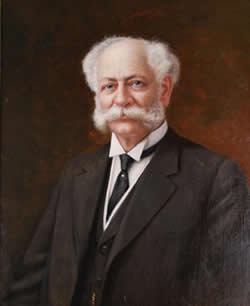
This small business soon evolved into Heinz, Noble & Company, taking on E. J. Noble as a third partner. Although the company was an instant success, the financial Panic of 1873 led the company into bankruptcy in 1875. At a Heinz family meeting on New Year's Day, 1876, Henry Heinz explained his debt-ridden situation but proposed a solution: if certain family members were to form a new company, he would work on salary and run the business. With support from his brother John, cousin Frederick, and wife Sarah, Heinz returned to the condiment business at the newly founded F. & J. Heinz Company. That year, Heinz introduced a new product—tomato ketchup—the company's most successful product yet today.
For the next few years, Heinz continued to expand the company's product line by adding apple butter, pepper sauce, and minced meat recipes. Because of his successful management, Henry J. Heinz was recognized publicly as the face of the company when its name changed to the H.J. Heinz Company. Elevated to the top position in the company, one of his first priorities was consolidating the Pittsburgh area Heinz offices and factories. Heinz decided to build his industrial complex on Pittsburgh's North Side (formerly Allegheny City), across the Allegheny River from Pittsburgh's old business section. In the midst of building the Heinz Co. headquarters from 1890—98, Henry Heinz launched one of the most remarkable, yet mysterious, events in food marketing: the Heinz "57 Varieties" campaign, begun in 1892.
Several rumors surround the meaning of the number "57." Although many feel that "57" must stand for the total number of varieties that the Heinz Co. offered in 1892, this story is untrue, since the company stocked over 60 varieties at the time of launch. Instead, Henry Heinz conceived the "57 Varieties" slogan when he was riding an elevated train in New York and spied an advertisement for "21 Styles" of shoes. Noticing its effect on himself, he perceived that a Heinz advertisement including a number would be just as memorable. After much thought about the best possible number, "57" surfaced as a perfect fit. Heinz wrote in his diary:
The idea gripped me at once and I jumped off the train at the 28th Street station and began the work of laying out my advertising plans. Within a week the sign of the green pickle with the '57 Varieties' was appearing in newspapers, on billboards, signboards, and everywhere else I could find a place to stick it.
Since the slogan's debut, the Heinz Co. and the number 57 continue to be associated with each other.
In addition to the Heinz 57 Varieties campaign, the company is famous for its marketing strategies involving a green pickle. At the 1893 World's Columbian Exposition in Chicago, the H.J. Heinz Co. exhibit was on the second floor of the Agricultural Building, a flight of stairs above foreign and imported food products. Many visitors would enter the building, but seldom would they climb the staircase. Heinz solved this dilemma by getting young boys to hand out white promise cards that could be exchanged for free souvenirs at the company exhibit. As Robert C. Alberts describes in The Good Provider, the souvenir was a "green gutta-percha pickle one and one quarter inches long, bearing the name Heinz and equipped with a hook to serve as a charm on a watch chain." The technique was an instant success, as the company handed out over a million pickle watch charms.
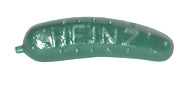
Later that year, a New York Times article, "Narrow Escape at World's Fair," reported that the massive crowds caused structural damage to the building, noting that "the gallery floor of the Agricultural Building has sagged where the pickle display of H.J. Heinz Company stood." Since its introduction, the pickle became synonymous with the H.J. Heinz Company and its founder, who was known throughout the country as the "Pickle King." The pickle souvenir tradition continues today; over 100 million Heinz pickles have been passed out at various trade shows and factory tours in the company's history.
The success of the Heinz pickle was the first of several advertising campaigns that enabled "Heinz" to become a household brand name. As mentioned in business historian Richard Tedlow's New and Improved, "most manufacturers [contemporaneous with the H.J. Heinz Co.] were unknown to the people who bought their products." Companies were not well known by their brand labels. By heavily advertising a standard label across various products, Henry Heinz used brand recognition to gain a competitive advantage over other companies. Exploiting the cross-referencing tendencies of consumers—and their admiration of memorable "57 Varieties" advertisements—enabled the H.J. Heinz Co. to succeed better than its competitors.
Henry J. Heinz openly invited the public to visit and tour the company's main facilities in Pittsburgh, an unheard of practice in the food industry. At the turn of the twentieth century, over 20,000 visitors inspected the factory annually. The company earned similar publicity for its two hundred jet black Heinz draft horses that delivered Heinz products throughout the country. Parades in Pittsburgh and southwestern Pennsylvania were not complete without a Heinz horse pulling a white wagon with green trimmings.
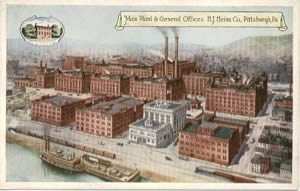
Eager to market Heinz during both the day and the night, the company constructed large electric outdoor signs—wildly expensive advertising novelties—to promote the Heinz Co. to passersby. A six-story sign on the corner of Fifth Avenue and 23rd Street in New York City illuminated a forty foot green pickle bearing the name Heinz and the words "57 Varieties Exhibited at Heinz Pier, Atlantic City." Originally leased in 1898 and later purchased and remodeled, the Heinz Pier adjoined the boardwalk with a classical façade. The inside, which extended 900 feet into the Atlantic Ocean, served as host to Heinz lectures, free taste tests of Heinz products, and even famous painting exhibits. The pier was open year round and immensely popular; an estimated 50 million people visited—and each guest was offered a Heinz pickle pin. However, after a destructive hurricane in September, 1944, Heinz management abandoned the Heinz Pier property.
The Heinz Company's recipe for national success coupled brand recognition with a commitment to product quality. Until the muckraking work of writers like Sinclair Lewis (The Jungle, 1906) and the resulting Federal Food and Drug Act of 1906, food processing was unregulated in the United States. As a result, many individuals contracted illnesses from eating contaminated products that could contain unlisted fillers, both intentionally and unintentionally. The Heinz Co. calmed these fears by consciously packaging its products in clear bottles, enabling consumers to view the actual products that they purchased.
The company also emphasized cleanliness in its production lines, particularly the process of bottling pickles. Young women, mostly immigrants from across Europe, sanitized the bottles that other women would pack with pickles in a distinct design—all carefully overseen by older forewomen. In 1900, Henry Heinz travelled to the Exposition Universelle Internationale in Paris, France, to receive two gold medals, one for product quality and the other for factory conditions. At home, he openly called for federal regulations over the production, labeling, and sale of goods by the food processing industry. Through its dedication to food quality, the Heinz Co. created a responsible, and enviable, model for consumer safety.
After its domestic success in the nineteenth century, the H.J. Heinz Company began to transition from a domestic, private firm to an international, public company in the twentieth century. In 1900, H.J. Heinz incorporated the company; six family members owned shares in the company. At this time, the H.J. Heinz Co. was first in the production of ketchup, pickles, mustard, and vinegar in the United States. Five years later, in 1905, Heinz expanded overseas when the company opened its first international factory in England. Unfortunately, at the age of 75, Heinz Company founder H.J. Heinz died in 1919. The management of the business remained in the family, however, as Howard Heinz succeeded his father as company president. Howard Heinz successfully rescued the company at the height of the Great Depression in 1931 by introducing two new product lines: ready-to-eat soups and baby food.
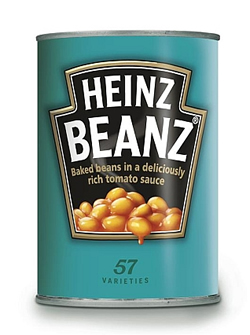
In 1928, the British Heinz subsidiary stopped importing Heinz beans from the United States and Canada and began to produce its own, permitting cheaper, yet more popular, bean production. The Heinz Company would later strike marketing gold in 1967 with the U.K. advertising slogan "Beanz Meanz Heinz;" its success and hundreds of variations compares only to the "57 Varieties" campaign of a half-century earlier.
Following the death of Howard Heinz in 1941, his son, H.J. "Jack" Heinz II took control of the company. He followed his grandfather's example of company growth by expanding the H.J. Heinz Co. domestically through acquisitions and internationally by launching Heinz subsidiaries. Jack Heinz already had previous expansion experience, as he had directed the company's development in Australia during the 1930s. Although Heinz products had been available in Australia for 50 years, the company cemented its position there when it built a production plant in Richmond, Victoria, in 1934. The subsidiary, Heinz-Australia, would become the nation's largest food processing plant. When the company had its first public offering in 1946, sales figures revealed that the H.J. Heinz Company earned over $4 million in net profits. Strong sales internationally—particularly of Heinz canned beans in England and Australia—enabled such positive financial news.
Success in the English and Australian markets encouraged the Heinz Co. to launch new subsidiaries in the Netherlands, Venezuela, Japan, Italy, and Portugal. Jack Heinz also began a new company practice of brand acquisition. The Heinz Co. purchased StarKist Foods, a tuna producer that was home to the cartoon mascot Charlie the Tuna, and Ore-Idea Foods, Inc., a top frozen potato company, in 1963 and 1965, respectively. After twenty five years as president and chief executive, Jack Heinz stepped down amidst a changing food industry of supermarket chains and new distribution systems.
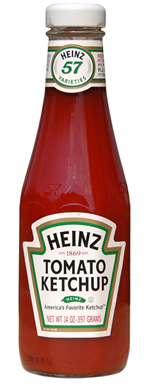
At the end of an interim president and CEO period, the Heinz Co. named Anthony (Tony) J.F. O'Reilly the president of the corporation in 1973 and CEO in 1979. Due to his success managing the British Heinz subsidiary, O'Reilly was promoted to the chairperson position after the death of Jack Heinz in 1987. He was the first person outside the Heinz family promoted to the position of president. April Dougal Gasbarre in International Directory of Company Histories refers to the decades under O'Reilly's management as "The O'Reilly Revolution." O'Reilly set out to make the Heinz Co. more profitable while retaining its majority share in various markets. In his "nickel-and-dime" strategy, he cut costs by switching to thinner glass bottles for ketchup, decreasing the size of StarKist tuna cans, and reusing heat and water in Heinz factories.
However, O'Reilly continued in the Heinz tradition of brand acquisition, albeit more conservatively. These acquisitions were timely in light of supply and demand and the public health consciousness. In 1975, Heinz obtained Hubinger Company, a major manufacturer of high-fructose corn syrup; this new supply enabled Heinz to earn high profits when the price of sugar soared. Three years later, in 1978, O'Reilly acquired Weight Watchers International. When the obsession with fitness and calorie-conscious diets swept the country, the Heinz Co. cashed in with profits.
In addition to these domestic acquisitions, O'Reilly expanded Heinz into the untapped markets of Asia and Africa. Heavy investments in Zimbabwe's Olivine Industries, Inc., earned Heinz a 51% controlling interest in the food manufacturer as of 1982 (resold to the Cotton Company of Zimbabwe in 2007). O'Reilly also initiated more expansion into the South Pacific, purchasing a majority share in Win-Chance Food of Thailand in 1987; Heinz quickly added tomato ketchup to the subsidiary's line of baby food and dairy products. Effective acquisitions facilitated a decade of high profits in the 1980s.
The growth of private labels products in supermarkets coupled by a small economic recession influenced O'Reilly to pursue a thorough reorganization of the global H.J. Heinz Company. In the United States, reorganization equaled the closing or sale of over a dozen plants and reductions in workforce and management employees. To reverse losing competition with private labels, Heinz cut back on advertising, shifting these resources to discounting popular products. Internationally, Heinz solidified its position in the Asia/Pacific sphere by purchasing New Zealand's Wattie's Limited in 1992 for $300 million. O'Reilly compared Wattie's to a "mini-Heinz;" the new subsidiary gave the Heinz Company a commanding control of the Australian market.
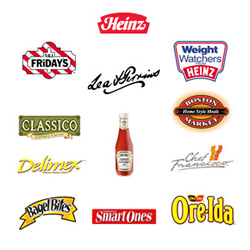
During the restructuring of the 1990s, Heinz exchanged new acquisitions with divestments of certain brands. In 1994, Heinz purchased the All American Gourmet Company, the producers of the Budget Gourmet line of frozen entrees (resold to rival Luigino's in 2001). Pet food operations also expanded with the acquisition of the Kibble'n Bits (later sold to Del Monte in 2002), Gravy Train, and Ken-L Ration brands from the Quaker Oats Company in 1995. The major divestments included the sale of Hubinger Company in 1993, the foodservice operations of Ore-Ida in 1997 (Heinz retained the Ore-Ida retail rights), and the diet food unit of Weight Watchers in 1999 (although Heinz continues to produce products under the Weight Watchers brand). With his restructuring plans a vast success, O'Reilly stepped down to nonexecutive chairman, allowing William R. Johnson, a Heinz employee since the mid-1980s, to become president and CEO of the Heinz Company. Johnson continued the cautious acquisition and divestment practices of his predecessor, ensuring sustained success for Heinz brands into the twenty-first century.
Continuing in the successful advertising campaigns of "57 Varieties" and "Beanz Meanz Heinz," the Heinz Co. has had several other hit commercials in America. In the late 1970s, Heinz created a commercial to promote its rich, thick ketchup. The key scene features a close-up shot of ketchup slowly oozing out of a glass bottle, with the Carly Simon song "Anticipation" playing in the background. It ends with the slogan, "The taste that's worth the wait." (Click here to see the commercial at YouTube) Although getting ketchup out of a small-neck bottle can be a difficult and tedious task, Heinz claims this obstacle is only a minor setback. Over two decades later, Heinz would revisit to this iconic image of anticipation in a parody commercial that introduced its upside-down squeeze bottle of ketchup. The camera focuses on a woman waiting for her ketchup to pour out of a glass bottle, with Simon's "Anticipation" again in the background. However, the sound of squeezing ketchup from a bottle interrupts the song, and the camera shifts attention to the woman's chuckling spouse. Packaged in squeezable plastic, this new ketchup is considerably easier to use than its predecessor. The commercial's ending slogan highlights this change, reading: "No Wait. No Mess. No Anticipation." See the commercial here.
From founder H.J. Heinz to current CEO William R. Johnson, the Heinz Company has succeeded because of its commitment to quality—from food processing to end products—throughout the world. Part of this prosperity stems from loyalty to what biographer Robert C. Alberts refers to as H.J. Heinz's "8 Important Ideas:"
1. Housewives are willing to pay someone else to take over a share of their more tedious kitchen work.
2. A pure article of superior quality will find a ready market through its own intrinsic merit—if it is properly packaged and promoted.
3. To improve the finished product that comes out of the bottle, can, or crock, you must improve it in the ground, where and when it is grown.
4. Our market is the world.
5. Humanize the business system of today and you will have the remedy for the present discontent that characterizes the commercial world and fosters a spirit of enmity between capital and labor.
6. Let the public assist you in advertising your products and promoting your name.
7. Earn the trust of the public for purity.
8. If people could work together in the Sunday School movement and use it to teach children to believe in the golden Rule, there might be lasting peace in the world.
The "family wisdom" of the first seven ideas, accrued during four decades of managing his business, enabled H.J. Heinz to construct a celebrated brand now recognizable across the globe. As Gasbarre describes, the Heinz Company adheres to a "continuous revolution and renewal:" brand acquisitions like Ore-Ida and StarKist; necessary divestments like Hubinger and Weight Watchers; global expansion into Africa and the South Pacific; and memorable marketing campaigns "57 Varieties" and "Beanz Meanz Heinz."
According to the Heinz Company's website, the firm earned over $10 billion in global revenue during Fiscal 2008. Eighty percent of Heinz revenue comes from six main categories: convenience meals, frozen foods, infant foods, pet food, tuna—and ketchup. In fact, sales figures suggest that Heinz sells over 600 million bottles of ketchup, its flagship condiment, every year. However, Heinz ketchup is packaged in more just in bottles as the company provides the single-serving packets of ketchup to fast food giant McDonald's. On top of these domestic sales, the Heinz Co. earns a large portion its profits abroad—over 1.5 million cans of Heinz beans are sold in the United Kingdom every day.
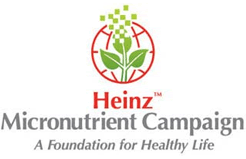
While much of the money the Heinz Company has earned over the years has been reinvested in research, marketing, and acquisitions, a significant amount of the "ketchup money" has been donated to philanthropic endeavors. Many of these contributions stem from H.J. Heinz's 8th Important Idea and the desire to build good character and good citizenship. In its hometown of Pittsburgh, Pennsylvania, the Heinz Company remains an active face of the community. Heinz family members operate the Heinz Endowments, a 2007 merger of the Howard Heinz Endowment and the Vira I. Heinz Endowment. Although not directly associated with the company, the privately-run Endowment contributes over $60 million in grants to nonprofit organizations annually.
The Heinz Company has its own philanthropic institution, the H.J. Heinz Company Foundation, which supports numerous community projects in Greater Pittsburgh. These ventures include the Union Project, a social enterprise organization, and Big Brothers & Big Sisters, a mentoring program. This generosity is not limited to the United States, however. The Foundation's signature program, the Heinz Micronutrient Campaign (HMC), operates to combat "the global health menace of iron-deficiency anemia and vitamin and mineral malnutrition in the developing world," according to its campaign website. Since its launch in 2001, the HMC researches, develops, and distributes micronutrient packets, which contain a multivitamin and mineral powder, to children suffering from malnutrition in developing countries like China, India, and Indonesia. The campaign has already assisted over 2.5 million children, with a goal of 10 million children by 2010. This global community pledge provides the H.J. Heinz Company a clear outlook on its future: the altruistic improvement of world health from company earnings.
The present H.J. Heinz Company has redefined its founder's adage on business success in terms of society: "To do an uncommon thing commonly well brings success."
Sources:
- Alberts, Robert C. The Good Provider: H.J. Heinz and His 57 Varieties. Boston: Houghton Mifflin, 1973.
- "Company News; Heinz Sells Budget Gourmet Frozen Lines to Luigino's." New York Times 10 Feb. 2001: C3.
- Dienstag, Eleanor Foa. In Good Company: 125 years at the Heinz Table, 1869—1994. New York: Warner, 1994.
- Gasbarre, April Dougal and David E. Salamie. "H.J. Heinz Company." International Directory of Company Histories. Ed. Jay P. Pederson. Detroit: St. James P. 36 (2001): 253—57.
- "History History." Heinz. 2008. 7 Jul. 2009. <http://www.heinz.com/our-company/about-heinz/history.aspx>.
- "Heinz Micronutrient Campaign." Building a Better World: Report to the Community (2007). Pittsburgh, PA: Heinz Company Foundation, 2007: 3—6. <http://www.heinz.com/data/pdf/foundation07.pdf>.
- Murray, Barbara. "H.J. Heinz Company." Hoovers, Inc. 2009. 7 Jul. 2009. <http://premium.hoovers.com/subscribe/co/factsheet.xhtml?ID=rfjsyffcyrxxcj>.
- "Narrow Escape at World's Fair." New York Times 15 Nov. 1893: 5.
- Ndlela, Dumisani. "Olivine's Road Ahead Could Still be Rutted." BizCommunity.com. 16 Jan 2008. 13 July 2009. <http://africa.bizcommunity.com/Article/411/82/21037.html>.
- Tedlow, Richard S. New and Improved: The Story of Mass Marketing in America. New York: Basic Books, 1990.
- "Welcome to Heinz Endowments." The Heinz Endowments. 2009. 13 Jul. 2009. <http://www.heinz.org/default.aspx>.
